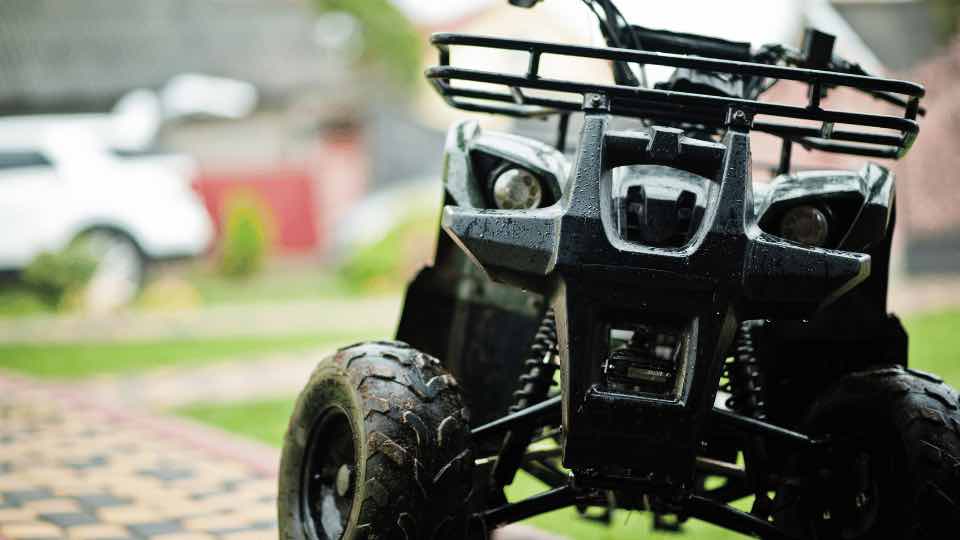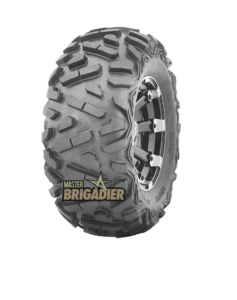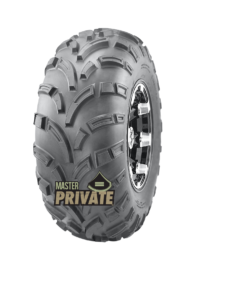How Changing ATV Tires Can Optimize Performance of Your Four Wheeler
Eric Johnson2023-09-25T01:25:41-05:00In this article:
How Changing ATV Tires Can Optimize the Performance of Your Four Wheeler
Choosing the Right Tire Tread Design for Your Off-Roader
ATV and UTV Handling and Stability
Shock Absorption, Stiffer Sidewalls and ATV Ride Comfort
ATV and UTV Tires Flotation
Durability and Puncture-Resistance for ATV and UTV Tires
Do You Need Self-Cleaning ATV Tires?
ATV Tire Load Capacity
You Won’t Find a Better Selection of Top Quality ATV Tires and UTV Tires than at Treadworld.com

How Changing ATV Tires Can Optimize the Performance of Your Four Wheeler
As you know, ATV tires and UTV tires play a critical role in the performance of your quad since they are the primary point of contact between the vehicle and the terrain, and are essential to optimal traction, stability, shock absorption, load capacity, and safety, just for instance. A deficiency by your current tires relating to any of those factors may lead you to decide it’s time to change the tires on your all-terrain vehicle or utility terrain vehicle. And, of course, there’s another factor “terrain,” which is so important it’s included in the name of both types of off-road vehicles. The type of terrain you primarily ride on should play a significant role in tires you run on your machine because different tire designs and tread patterns are optimized for specific terrains such as mud, sand, rocks, or hard-packed trails. But let’s not get ahead of ourselves. The tire experts at Treadworld are here to provide you with information relating to how you can tell if you have the best ATV tires and the best UTV tires for the way you use your 4-wheeler, or if it’s time to upgrade.
Choosing the Right Tire Tread Design for Your Off-Roader
Selecting the best tread pattern for your ATV tires—to provide optimal performance—is a little like buying shoes for sports. You wouldn’t wear hiking boots when you’re running a 10k, and you wouldn’t put on golf spikes to play basketball.  Similarly, choosing the best ATV tires with the right type of tire tread design is essential for the type of riding you’ll be doing. Your decision can be based on several factors. Terrain: tires to be used primarily on rocky terrain should be different than the tires you want for riding on pavement or hardpack. Sand ATV tires are designed differently than tires designed specifically to go through mud. All terrain ATV tires, or trail tires, are the most versatile ATV tires, and come in a variety of tread patterns designed to handle a wide range of off-road situations. All terrain tires tend to have squared or lateral lugs that are set close to each other to provide a wide contact patch, with a tread depth varying from ½-inch to 1-inch to provide dependable traction and a smooth ride. ATV mud tires designed to be used primarily in mud pits have wide, inside-to-outside, angled lug patterns with a more directional tread, with depths from 1-inch to 2-inches, with additional lugs on the shoulder to help grip muddy ruts. If you’re riding rocky terrains, you want a tighter tread pattern that will provide a larger contact patch, that also has more deeply angled grooves to make climbing rocks easier. Performance Needs: for instance, if you engage in recreational activities like racing or aggressive trail riding, you may prioritize tires that have a lower profile design and closely spaced, lugs to provide superior acceleration, cornering stability, and braking performance. For utility purposes, such as hauling or towing heavy loads, tires with medium size lugs and a versatile tread pattern, along with a higher load-carrying capacity may be necessary. Weather Conditions: if you ride in diverse weather conditions, including wet or snowy environments, you’ll want to consider off-road tires that provide enhanced traction and handling under those specific conditions. By considering these factors, you can make an informed decision about when to change the tires on your ATV or UTV and select the most suitable tires for your current specific needs and riding conditions.
Similarly, choosing the best ATV tires with the right type of tire tread design is essential for the type of riding you’ll be doing. Your decision can be based on several factors. Terrain: tires to be used primarily on rocky terrain should be different than the tires you want for riding on pavement or hardpack. Sand ATV tires are designed differently than tires designed specifically to go through mud. All terrain ATV tires, or trail tires, are the most versatile ATV tires, and come in a variety of tread patterns designed to handle a wide range of off-road situations. All terrain tires tend to have squared or lateral lugs that are set close to each other to provide a wide contact patch, with a tread depth varying from ½-inch to 1-inch to provide dependable traction and a smooth ride. ATV mud tires designed to be used primarily in mud pits have wide, inside-to-outside, angled lug patterns with a more directional tread, with depths from 1-inch to 2-inches, with additional lugs on the shoulder to help grip muddy ruts. If you’re riding rocky terrains, you want a tighter tread pattern that will provide a larger contact patch, that also has more deeply angled grooves to make climbing rocks easier. Performance Needs: for instance, if you engage in recreational activities like racing or aggressive trail riding, you may prioritize tires that have a lower profile design and closely spaced, lugs to provide superior acceleration, cornering stability, and braking performance. For utility purposes, such as hauling or towing heavy loads, tires with medium size lugs and a versatile tread pattern, along with a higher load-carrying capacity may be necessary. Weather Conditions: if you ride in diverse weather conditions, including wet or snowy environments, you’ll want to consider off-road tires that provide enhanced traction and handling under those specific conditions. By considering these factors, you can make an informed decision about when to change the tires on your ATV or UTV and select the most suitable tires for your current specific needs and riding conditions.
ATV and UTV Handling and Stability
Changing your ATV tires can improve overall handling and stability. While it’s the tire’s contact patch—the area of the tire in contact with the ground—that provides stability and helps with balance, it’s the design and construction of the tire sidewalls that impact the ATV’s responsiveness to steering inputs and its ability to handle corners smoothly. ATV UTV tires with appropriate tread patterns and construction allow for better cornering, braking, and maneuverability, which can significantly enhance your riding experience and control, over various terrains. Tires with a more aggressive tread pattern and sidewall construction can provide better grip in corners, reducing the chances of sliding or losing control. This can have the added benefit of enhancing your confidence in handling tight turns and uneven surfaces. However, very aggressive treads can result in a rougher ride on hard-packed surfaces, leading to decreased stability and handling. Tires with a more moderate tread pattern strike a balance between off-road traction and on-road stability, offering sufficient grip on a variety of terrains, including hard-packed trails, gravel, and light mud, plus they generally supply a smoother and more stable ride on roads and groomed surfaces.
Shock Absorption, Stiffer Sidewalls and ATV Ride Comfort
If riding your ATV presents you with challenges relating to ride comfort, your tire choice could be a contributing factor. Tires play a crucial role in the comfort of your ATV ride because, to start, they’re a major component of the vehicle’s suspension system and play a large role in absorbing shock. The construction and materials used in ATV tires greatly affect their shock absorption capabilities. ATV tires with stiffer sidewalls generally provide better handling and stability. They are less prone to sidewall flex, which enhances their ability to maintain precise control during cornering, and at higher speeds. However, the trade-off is that stiffer sidewalls transmit more shocks and vibrations from the terrain to you, leading to a jarring, rougher, less comfortable ride. On the other hand, ATV tires with more flexible sidewalls are generally known for providing a smoother and more comfortable ride. The flexibility allows the sidewalls to absorb impacts and deform to conform to uneven terrain, resulting in reduced shock transmission to the rider. This can be particularly beneficial for off-road riding on rough, bumpy trails where comfort is a priority, reducing rider fatigue and promoting longer and more enjoyable rides. However, more flexible sidewalls may compromise some aspects of handling and stability, especially during aggressive maneuvers or high-speed riding.
Additionally, the tread design of ATV tires plays a vital role in their shock absorption abilities leading to ride comfort. Tires with deeper and more aggressive treads can more effectively absorb shocks on uneven surfaces. The deep treads help the tire flex and conform to the terrain, reducing the impact felt by the rider.
On the other hand, if you do a lot of riding in soft or loose terrain such as mud, sand, or snow, you want tobe sure your tires provide sufficient flotation. Flotation refers to the ability of the tires to stay on or near the surface of the terrain without sinking in. Wider ATV tires generally provide better flotation

in soft terrain because the increased contact area spreads out the weight of the ATV, reducing the pressure exerted on the ground and minimizing the risk of sinking. Broader tires offer improved stability and flotation in mud, sand, and snow compared to narrower tires. In addition, the tread pattern of ATV tires also affects flotation. Tires with aggressive, deep-lug tread patterns tend to perform better in soft terrain as they can dig into the surface and provide traction. On the flip side, tires with smoother or shallower tread patterns may struggle to maintain flotation in challenging conditions. The design and construction of ATV tires can impact flotation as well. Tires with a flexible sidewall and a more rounded profile tend to conform better to the terrain, distributing the weight and improving flotation. Finally, while not directly related to tire choice, riding technique plays a role in flotation. Maintaining momentum, avoiding sudden stops or sharp turns, and using proper throttle control can help improve flotation by reducing the risk of getting stuck or sinking in soft terrain.
The bottom line is that if the tires you’re using now don’t give you the edge you flotation edge you need in the specific terrain and conditions you often encounter, allowing your machine to sink into the turf, it may be time for changing ATV tires.
Durability and Puncture-Resistance for ATV and UTV Tires
High-quality tires, like you’ll find here at Treadworld, are typically made from durable materials like reinforced rubber compounds, which offer better resistance to punctures, cuts, and impact damage, especially if you ride in rugged or off-road terrains that may contain sharp rocks, branches, or other potential hazards. Stiffer sidewalls also offer better resistance to sidewall punctures and cuts, making them more suitable for rugged terrains and aggressive riding styles. That’s important with regard to tire damage, which can lead to air loss, potentially leave you stranded on the trail, and a short tire lifespan. What you want is enhanced off-road performance, control and safety that allow you to navigate challenging trails without constantly worrying about tire damage.
Do You Need Self-Cleaning ATV Tires?
Choosing ATV tires that are self-cleaning and designed for specific terrains, such as mud tires, often means an aggressive tread pattern with wider spacing that helps the tires self-clean by shedding mud, dirt, and other debris as the tires rotate. Self-cleaning tires feature tread patterns and designs that facilitate the quick expulsion of mud and debris as the tire rotates, helping to maintain a clean tread surface, and allowing the tires to make better contact with the ground for improved traction, better acceleration, maneuverability, and overall performance. Also to be considered is that mud or debris accumulation in the tire treads can add weight and increase rolling resistance, which means decreased performance and fuel efficiency, and can cause imbalance or uneven weight distribution which impedes stability and control. Then there’s maintenance time to consider. Cleaning mud or debris from ATV tires after every ride can be time-consuming and labor-intensive. Less time required for cleaning means more time enjoying your ride.
It’s important to note that while self-cleaning tires offer advantages in muddy or sticky conditions, they may not be optimal for offering the traction on hard surfaces, durability, and load-carrying capacity in other riding situations.
If the load capacity of your current ATV tires is insufficient, it’s time to get new ATV tires. Tires that provide an optimal load capacity are crucial for several reasons, starting with safety. Load capacity directly impacts the safe operation of an ATV. Each tire has a specific load rating that indicates the maximum weight it can safely carry, and overloading the tires beyond their capacity will not only negatively affect performance, but can lead to tire failure, reduced traction, and compromised handling—while also increasing the risk of accidents, loss of control, and tire blowouts. When tires are overloaded, they may experience excessive heat buildup, increased wear and tear, and reduced lifespan. In addition, overloading the tires places excessive stress on the tire structure, leading to accelerated wear, sidewall damage, and increased likelihood of punctures or blowouts.
When considering the load capacity of ATV tires, take into account not only the weight of the ATV itself but also the weight of any passengers, cargo, or equipment that may be carried. It is essential to know the total weight that the tires will need to support in various riding conditions.
You Won’t Find a Better Selection of Top Quality ATV Tires and UTV Tires than at Treadworld.com
When you’re considering buying new tires for your ATV or UTV, you owe it to yourself to check out the Treadworld selection of Master Tires. Count on us to provide you with the high-performing, long-lasting ATV tires and UTV tires you can depend on for long life. Choose from 14 different styles that include a wide variety of tread patterns to perfectly fit your outdoor adventures, in 28 different sizes to accommodate a wide range of ATV and UTV brands. All our Master ATV Tires and Master UTV Tires as well as all our RubberMaster Tires are manufactured to strict tolerances from top rubber compounds, then triple-tested for quality, balance and uniformity before being X-rayed to be sure they’re perfect. All our dent-proof, crack-proof and virtually indestructible SteelMaster Wheels are manufactured from tough, durable steel then put through several quality checks to provide you with dependable quality. Expect easy ordering, and fast shipping, plus your satisfaction is guaranteed with our no-hassle Ultimate Advantage Warranty. Don’t hesitate to contact our tire experts via live chat or email with any questions you may have, and to get the ideal ATV and UTV tires—or the perfect trailer tires, lawn and garden tires, agriculture tires and many others—from our extensive selection. Or use our Treadworld Product Selector Tool to help you find exactly what you want.
